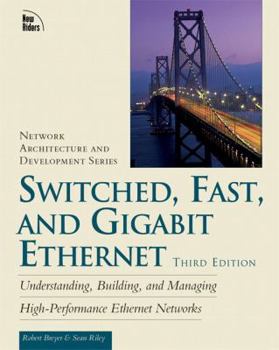Switched, Fast, and Gigabit Ethernet: Understanding, Building, and Managing High-Performance Ethernet Networks
LANs no longer serve only to help office workers share printers and exchange files. The future of the LAN runs heavily to bandwidth-intensive applications. The authors of Switched, Fast, and Gigabit... This description may be from another edition of this product.
Format:Hardcover
Language:English
ISBN:1578700736
ISBN13:9781578700738
Release Date:January 1998
Publisher:Sams
Length:650 Pages
Weight:3.00 lbs.
Dimensions:1.7" x 7.6" x 9.4"
Related Subjects
Computers Computers & Technology LAN Networking Networks, Protocols & APIs SoftwareCustomer Reviews
5 ratings
The Only Book You Need on your Desktop....
Published by Thriftbooks.com User , 24 years ago
I used this book for my CCIE exam preparation. I have zillion other titles on Ethernet and switching. Excellent repeat Excellent Book. Not only is the book well presented but also well structured. I agree with the reader who said in his review, "if there is just one ethernet book u'll ever buy, make sure this IS it!"
Outstanding organization
Published by Thriftbooks.com User , 25 years ago
I was really pleased with both the information containted in this book as well as the manner in which it was presented. This book's organization makes it great for a "cover-to-cover" read (on a VERY long weekend!) or for a quick reference check.If I could only have one Ethernet book on my shelf, this would be it.
Great overview with excellent detail where appropriate.
Published by Thriftbooks.com User , 25 years ago
As someone designing a network upgrade, this book provides the detail I need. In several sections, a flowchart provided clear direction on what decision might be best for me and why. The authors are biased towards Cisco products ("the 7500 series would work very well in this situation") and don't mention enough competitive products. In summary, this book is probably targeted to LANS with either 200.
Outstanding Work
Published by Thriftbooks.com User , 25 years ago
This book taught me more about Ethernet - particularly Gigabit Ethernet - than I thought was possible to learn. It is technical but clear, conversational but detailed and thorough. Unlike other books whose authors claim to be objective, these writers are openly and unabashedly Ethernet "bigots" (to use their word). You may not agree with everything they say, but you have to take them seriously.Breyer and Riley have a rare combination of talents: extensive technical knowledge, and the ability to communicate their knowledge in an entertaining and informative style. First rate.
The definitive Ethernet handbook
Published by Thriftbooks.com User , 25 years ago
[note: this review appears in the June 1999 edition of SA Computer Magazine and is (c) 1999 DSBMedia (Pty) Ltd. Used with permission]Ethernet - it's a breeze, right? Buy a couple of NE2000 clones and some cable, slot the RJ-45 plugs into a hub, configure the basic client software and you've got a network. Well, a small 10Base-T network may be this simple to set up and a real no-brainer to manage, but today's bandwidth-intensive applications often require something somewhat more sophisticated. When you have a few hundred users shoving large files all over the place (and, let's not forget, being connected to that network resource-hog the Internet), you need to get into hardcore, high-speed networking.In the old days, networking was considered a Black Art, even by highly experienced IT people. There was a reason for this - networking really was a Black Art, practiced by a small clan of social misfits who probably drank squirrel blood in their spare time (actually, they probably read networking manuals, which was an activity roughly equivalent social unacceptability).Then networks became a tad more mainstream. Networking products appeared with documentation that was in an almost recognisable dialect of English, and "intelligent" hardware meant that - as often as not - you really could plug and play. Indeed, you could implement a reasonably effective 50-user network without really understanding what the hell you were doing, and kid yourself you were a networking expert.But now you need to move to the next level. And suddenly networking looks once again as if it's a Black Art. You start feeling as if it might be easier to decipher Minoan Linear A script than to grasp why your Ethernet performance is unnecessarily degraded.You need this book. Its subtitle tells us it's about "understanding, building, and managing high-performance Ethernet networks". And that's a pretty good description of what you'll be able to do if you read it from cover to cover and inwardly digest its contents (a remarkably straightforward process thanks to a clear and coherent writing style).Opening with a history of Ethernet that does an invaluable job of placing the current technologies in a meaningful context, the book goes on to cover every imaginable aspect of something which can involve far more complexity than you might possibly imagine. For example: I, for one, might have scoffed at the idea of reading 60-odd pages just on cabling. Until I read them, that is.Simple, hub-based 10Base-T Ethernet really is a no-brainer these days, and the authors waste no time on it. However, once you start adding bridges or switches into the equation it takes a quantum leap in complexity. And that's where this book really gets going. Then you start analysing bandwidth requirements and the need (or otherwise) for high-speed technologies ranging from the now-standard 100Base-T to Level 3 switching and 1000Base-T gigabit Ethernet, and you begin to realise t





